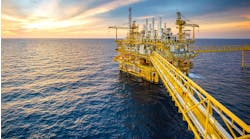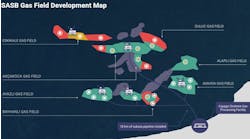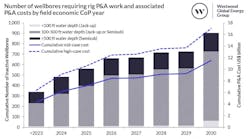Pam Boschee - Special Correspondent
As the offshore vessel, rig, and platform demand grows, so too does the demand on power suppliers to keep pace with gensets for auxillary and emergency power, automation and safety systems, cables, switchgear, and related services for lifecycle management.
ABB has received a contract from EPC contractor PT Sempec Indonesia to provide integrated electrical and control buildings with electrical, automation and safety systems, monitoring, and controls for a new oil-processing platform.
The platform, operated by Korea Development Co. Ltd., is offshore East Java, Indonesia, in the Poleng C field.
ABB will supply integrated 800xA automation and safety systems, 380V switchgear, motor control centers (MCC), and distribution boards in two fully assembled E-houses, one control building, and one electrical building. Fire suppression systems, fire and gas detectors, potable water systems, HVAC, and UPS also will be supplied for the buildings. In addition, ABB will provide engineering, supply, installation commissioning, and start-up, as well as training, of the integrated power and automation systems. The project is expected to be operational in March 2007.
Siemens Industrial Solutions and Services Group (I&S) has contracted with Daewoo Shipbuilding & Marine Engineering Co. to supply electrical equipment for a new semisubmersible offshore drilling rig. The final customer, Odfjell Invest Ltd., Hamilton, Bermuda, will use the rig for deepwater drilling operations in harsh environments.
Siemens has contracted with Daewoo Shipbuilding & Marine Engineering Co. to supply electrical equipment for a new semi offshore drilling rig for final customer, Odfjell Invest Ltd.
The order is worth around $18.9 million and the drilling rig is to be delivered in October 2008.
The new drilling rig will be the first of its kind with dual active heave compensating drawworks, says ABB. Sinamics S120 frequency converters will be used on the rig to control all drilling drives including the drawworks.
Siemens also will supply generators, transformers, medium- and low-voltage switchgear, and an uninterruptible power supply (UPS).
Earlier this year, the Chinese Yantai Raffles Shipyard, Yantai/Shandong, awarded a $44-million contract to a consortium led by Siemens Industrial Solutions and Services (I&S) for a new semisubmersible drilling platform designed for Offshore Rig Services, Stavanger, Norway. Consortium members include Siemens AS of Norway, Wärtsila Finland OY, and Kongsberg Maritime AS of Norway.
The consortium will supply diesel engine gensets, propulsion, power distribution, transformers, drives and motors, an uninterruptible power supply (UPS), a DP3 system, an integrated control and safety system, the telecom system, and auxiliary systems.
Cummins Mid-South may be best recognized for the installation of its main propulsion engines in the Gulf Coast shipbuilding industry. However, last month the company announced orders in some newer markets.
At Eastern Shipbuilding, Panama City, Florida, a DP2 platform supply vessel is being built for Harvey Gulf, and features three KTA38M2 engines, each generating 1,200 hp at 1,800 rpm, providing power for the 280-ft vessel’s two bow thrusters and single stern thruster.
In addition, the vessel will have three KTA19 DM -powered gensets and a single Cummins 6CTA8.3 DM-powered emergency genset.
HVDC Troll A-One year later
Last October, Statoil’s Troll A offshore gas production platform in the North Sea became the first offshore platform to be powered by a high-voltage direct current (HVDC) light electricity link originating on land (70 km undersea cable transmission).
An artist’s view of valves in the HVDC light converter station on the Troll A platform. These valves consist of high-power semiconductors. Each of the millions of silicon chips can turn on and off the power of a Formula One racing engine.
Operation of the gas train in Troll A includes two independently installed HVDC transmission systems based on voltage source converters operating as electrical drive systems together with Motorformers, which connect to large gas compressors.
Motorformers operate at high voltages of up to 70 kV (compared to 15 kV typically for a conventional motor) and can be connected with no need for a transformer or related secondary-side switchgear.
Since commissioning, some lessons have been learned and modifications have been made to handle the following situations:
- Platform blackout
- Emergency or process shutdown and startup
- Alarm presentations to the operators.
It has been demonstrated that certain systems could have been implemented in the platform’s own control, rather than as part of the HVDC light system’s MACH 2 controls, which provide microprocessor-based control, supervision, and protection. An example cited by ABB is the compressor pipeline’s bypass valves
The Motorformers have performed according to onshore factory acceptance tests and have operated on the offshore compressor skid with vibration levels below expected levels.
Extensive personnel training prepared by Statoil and ABB was provided in Sweden and Norway. Dedicated training was later carried out for operators and maintenance teams at Kollsnes and Troll A.
Because of the state-of-the-art equipment and control systems, training will be ongoing for selected, small groups.
A recent $50-million contract has ABB planning another undersea HVDC installation. As part of BP’s Valhall Redevelopment Project (see Offshore, August 2006), ABB will replace the offshore field’s onsite power, currently generated by gas turbines, with a 292-km power link from shore. Nexans Norway will install the subsea cable in two parts.






